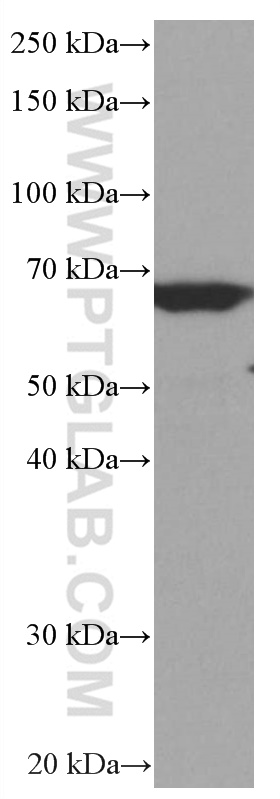验证数据展示
经过测试的应用
| Positive WB detected in | Raji cells |
推荐稀释比
| 应用 | 推荐稀释比 |
|---|---|
| Western Blot (WB) | WB : 1:1000-1:4000 |
| It is recommended that this reagent should be titrated in each testing system to obtain optimal results. | |
| Sample-dependent, Check data in validation data gallery. | |
发表文章中的应用
| WB | See 1 publications below |
产品信息
66947-1-Ig targets RELB in WB, ELISA applications and shows reactivity with Human samples.
| 经测试应用 | WB, ELISA Application Description |
| 文献引用应用 | WB |
| 经测试反应性 | Human |
| 文献引用反应性 | human |
| 免疫原 |
CatNo: Ag13824 Product name: Recombinant human RELB protein Source: e coli.-derived, PGEX-4T Tag: GST Domain: 264-579 aa of BC028013 Sequence: NVVRICFQASYRDQQGQMRRMDPVLSEPVYDKKSTNTSELRICRINKESGPCTGGEELYLLCDKVQKEDISVVFSRASWEGRADFSQADVHRQIAIVFKTPPYEDLEIVEPVTVNVFLQRLTDGVCSEPLPFTYLPRDHDSYGVDKKRKRGMPDVLGELNSSDPHGIESKRRKKKPAILDHFLPNHGSGPFLPPSALLPDPDFFSGTVSLPGLEPPGGPDLLDDGFAYDPTAPTLFTMLDLLPPAPPHASAVVCSGGAGAVVGETPGPEPLTLDSYQAPGPGDGGTASLVGSNMFPNHYREAAFGGGLLSPGPEAT 种属同源性预测 |
| 宿主/亚型 | Mouse / IgG1 |
| 抗体类别 | Monoclonal |
| 产品类型 | Antibody |
| 全称 | v-rel reticuloendotheliosis viral oncogene homolog B |
| 别名 | I REL, IREL, RELB, Transcription factor RelB |
| 计算分子量 | 62 kDa |
| 观测分子量 | 62-65 kDa |
| GenBank蛋白编号 | BC028013 |
| 基因名称 | RELB |
| Gene ID (NCBI) | 5971 |
| RRID | AB_2882271 |
| 偶联类型 | Unconjugated |
| 形式 | Liquid |
| 纯化方式 | Protein G purification |
| UNIPROT ID | Q01201 |
| 储存缓冲液 | PBS with 0.02% sodium azide and 50% glycerol, pH 7.3. |
| 储存条件 | Store at -20°C. Stable for one year after shipment. Aliquoting is unnecessary for -20oC storage. |
背景介绍
RELB, also named as Transcription factor RelB, is a 579 amino acid protein, which contains one RHD domain. RELB localizes in the nucleus and cytoplasm. RELB is a pleiotropic transcription factor which is present in almost all cell types and is involved in many biological processed such as inflammation, immunity, differentiation, cell growth, tumorigenesis and apoptosis.
实验方案
| Product Specific Protocols | |
|---|---|
| WB protocol for RELB antibody 66947-1-Ig | Download protocol |
| Standard Protocols | |
|---|---|
| Click here to view our Standard Protocols |


